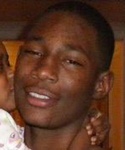
Being so close to Lincolnwood — and the suburb’s police — is one reason Nahla Yafai thinks her North Side neighborhood that’s part of Forest is safe. | Emily Gray Brosious / Sun-Times
By MICHAEL LANSU, FRANK MAIN and CHANTELLE NAVARRO
Chicago Sun-Times
In Chicago, where a dozen people were killed over the Memorial Day weekend and politicians are still talking about how they can stop filmmaker Spike Lee from calling the city “Chiraq,” four communities stand out as oases apart from the violence.
In Mount Greenwood, Edison Park, Forest Glen and North Park, not one person has been killed over the past three and a half years, a Chicago Sun-Times / Homicide Watch Chicago analysis shows.
“One of the reasons we moved here is it’s a safe area for kids,” says Bobbie Sue Tuxford, 31, who lives in Mount Greenwood on the city’s Southwest Side.
Mount Greenwood hasn’t recorded a murder since April 12, 2005, according to the analysis of crime data.
Edison Park, on the far Northwest Side, has gone even longer. It hasn’t had a murder since Dec. 14, 2002.
The Chicago Police Department also lists the Loop as having gone more than three years since the last murder downtown. But that’s because the police erroneously omitted the 2014 killing of Steven LaVoie, chief executive officer of the supply technology firm ArrowStream, at the Bank of America building at 21 S. LaSalle. LaVoie was killed by an employee, angry over a demotion, who also killed himself, according to the police.
Montclare, on the Northwest Side, didn’t have a killing since Aug. 28, 2010 —until 56-year-old Sandra Fellows was found strangled April 7 in the 6600 block of West Belden Avenue. Her boyfriend, has been charged in her death.
In sharp contrast, Austin has been the city’s deadliest community since 2001 —as far back as the city’s crime database goes — with more than 500 people killed. It’s followed by Englewood and Humboldt Park.
Bob Tracy, chief of crime strategy for the police department, says Edison Park, Montclare and the other communities with the fewest murders in Chicago have something in common: not much of a gang problem.
Tracy says the department recognizes that those communities don’t need as many cops as high-crime areas like Austin do. So it deploys officers based on a three-year analysis of murders, shootings and robberies on a population density map, he says. The deployment plan “is fluid,” he says.
What else sets Mount Greenwood, Edison Park, Forest Glen and North Park apart? People who live in those parts of the city and experts on crime in Chicago credit factors such as a sense of ownership in the community and a large number of police officers and firefighters living down the block.
Nahla Yafai, 27, who lives in Sauganash, a North Side neighborhood that’s part of Forest Glen, says part of the reason it’s so safe is its proximity to the suburbs — and suburban police.
“If the suburbs are really strict on how they run their community, it’s going to reflect on Sauganash because it’s so close,” says Yafai. “If I cross the street, I’m in Lincolnwood. There is always Lincolnwood police around my neighborhood.”

Bobbie Sue Tuxford, 31, who lives in Mount Greenwood sees an obvious reason her neighborhood is so safe. “There is a lot of military people, veterans, police officers, firefighters,” Tuxford says. “All of the city workers pretty much live in this area.” | Emily Gray Brosious / Sun-Times
Tuxford credits the people who live in her neighborhood with helping to keep Mount Greenwood safe.
“There is a lot of military people, veterans, police officers, firefighters,” Tuxford says. “All of the city workers pretty much live in this area.”
According to census data, 15,228 “law enforcement workers” live in Chicago, including about 12,100 police officers. Mount Greenwood, Edison Park and Forest Glen have some of the highest percentages of residents in the city working in law enforcement.
Crime in general is also low in these communities. For instance, between 2012 and 2014, not a single person was shot in Edison Park, which also reported only one criminal sexual assault. Forest Glen reported two sexual assaults. North Park had just 13 burglaries — which police Supt. Garry McCarthy calls a bellwether crime.
The city’s safest communities also have a high percentage of home ownership.
More than 90 percent of Mount Greenwood residents live in a home their families own, according to U.S. census data — the highest percentage among the 77 “community areas” defined by the city of Chicago.
Forest Glen is second on that list, with almost 88 percent home ownership. Edison Park is sixth, at nearly 80 percent. All are well above the citywide average of 46 percent.
Home ownership gives people a strong sense of being invested in their communities, says John Lally, who grew up in Edison Park and moved back to rear his family.
“Having a lot of single-family homes helps,” says Lally, 37. “People take a big interest and great pride in looking out for their neighbors and themselves.
“I think it’s a generational thing,” Lally says. “A lot of people raise their families here or were raised here themselves.
“I used to live in Lincoln Square. There are a lot more apartment buildings there. A lot of people are there just a year or two.”
Edison Park is also home to a high percentage of police officers and firefighters, some of them looking for a suburban type of neighborhood but required to live in the city because of their jobs.
Former Ald. Mary O’Connor (41st), whose ward included Edison Park, says, “There isn’t a block in our ward that doesn’t keep a close watch on things. We have a community that keeps an eye on the neighbors. And we believe they are extremely sensitive to recognizing issues and responding promptly.”
Another factor that stands out about some of the safest communities is wealth.
The average household income in Forest Glen is $89,442 a year, tops in the city, according to the latest census figures.
Mount Greenwood is third, at $86,546, and Edison Park is sixth, at $81,418 — all well above the citywide average of $47,408 a year.
Yet North Park, which hasn’t had a murder since July 22, 2011, ranks only 22nd in median household income, as well as 28th in percentage of owner-occupied residences.
Andrew Papachristos, a Yale University sociologist from Chicago who has studied crime in the city, says networks of people who solve their conflicts with guns have plagued parts of low-income neighborhoods like Austin and Englewood for decades. Those networks never developed in places like Mount Greenwood and Edison Park, according to Papachristos.
People in low-income neighborhoods tend to have a strong sense of community — with families living there for generations and looking out for one another, Papachristos says. But many young men have gravitated over the years toward gangs in those same neighborhoods, he says.
Papachristos says a third of the men living tin some low-income neighborhoods wind up with felony convictions, which makes it hard for them to get jobs.
It’s a self-perpetuating cycle of poverty and violence that isn’t present in the city’s wealthier neighborhoods, Papachristos says.
Still, he says there are parts of poorer neighborhoods that are as safe as anywhere.
“Even in the worst neighborhoods, most blocks don’t have a homicide,” he says. “This is a very localized thing.”







